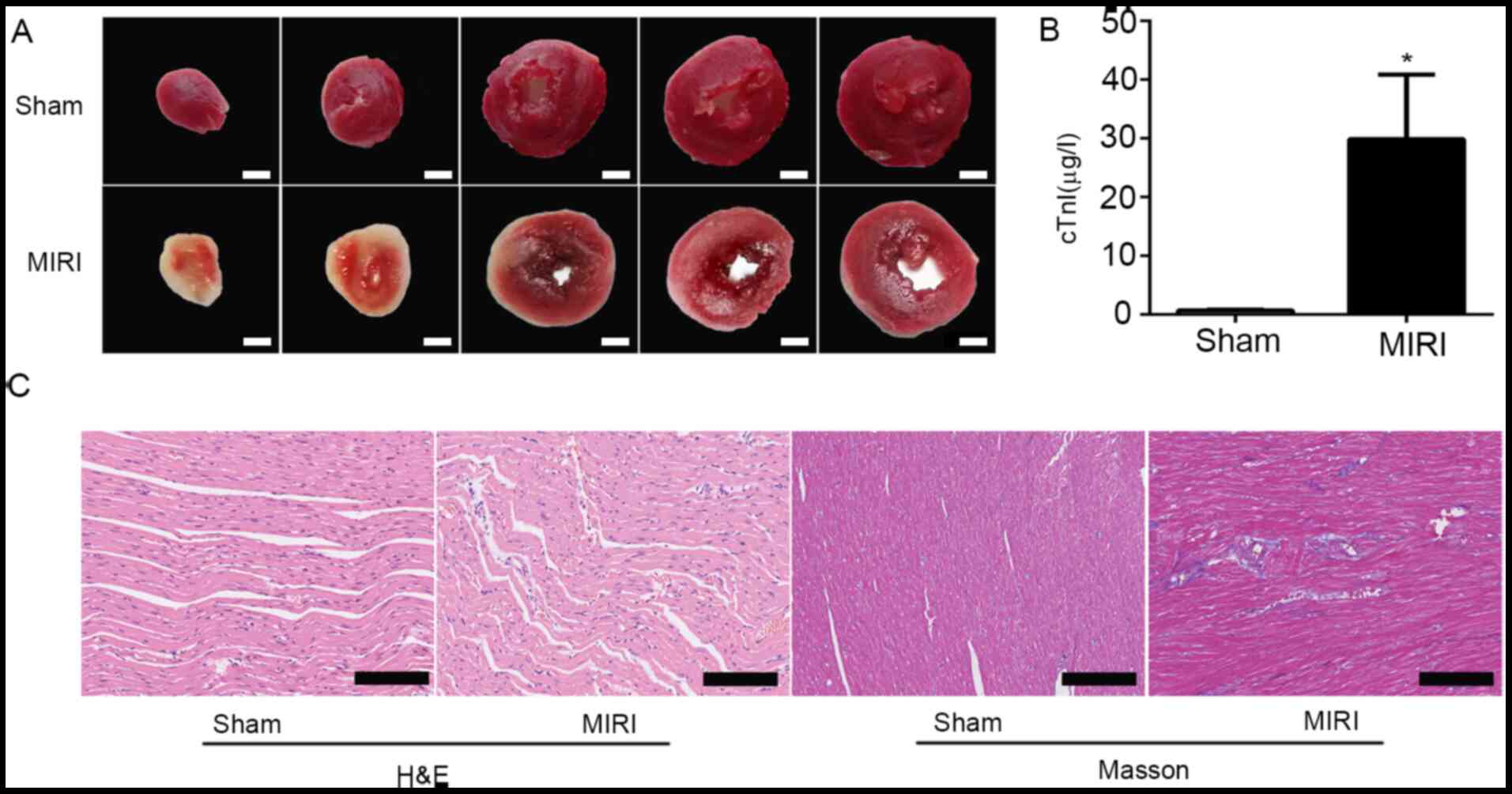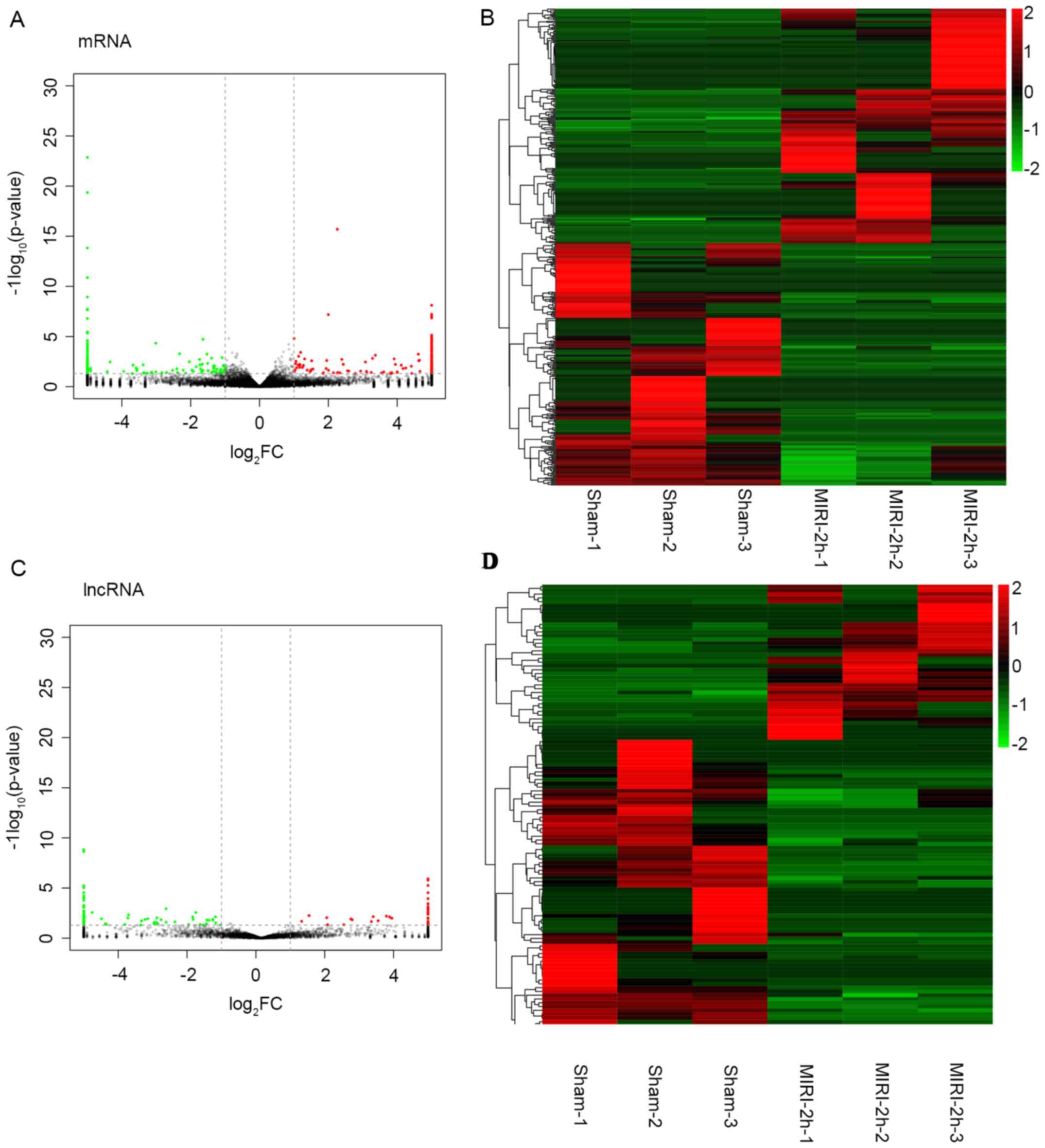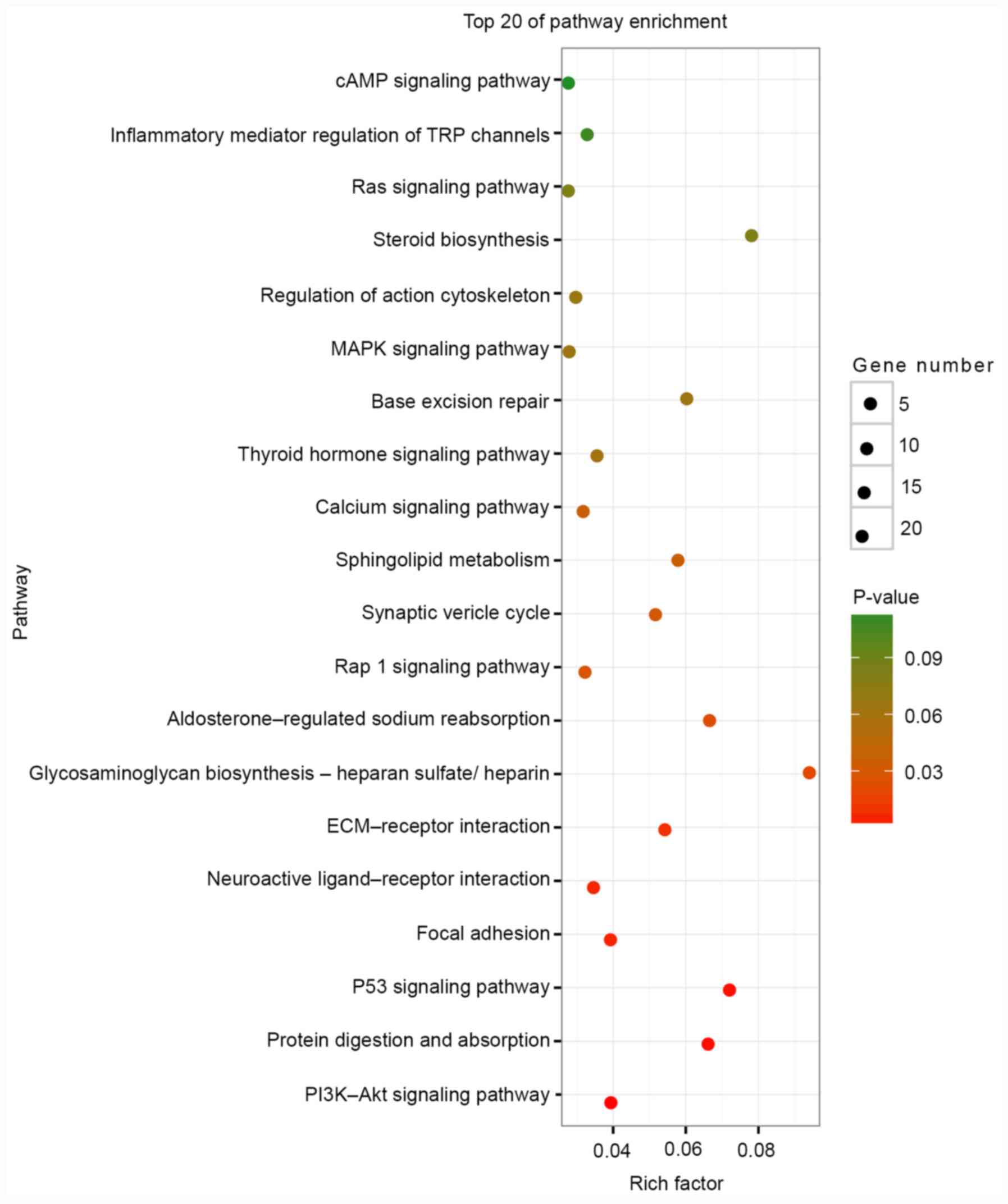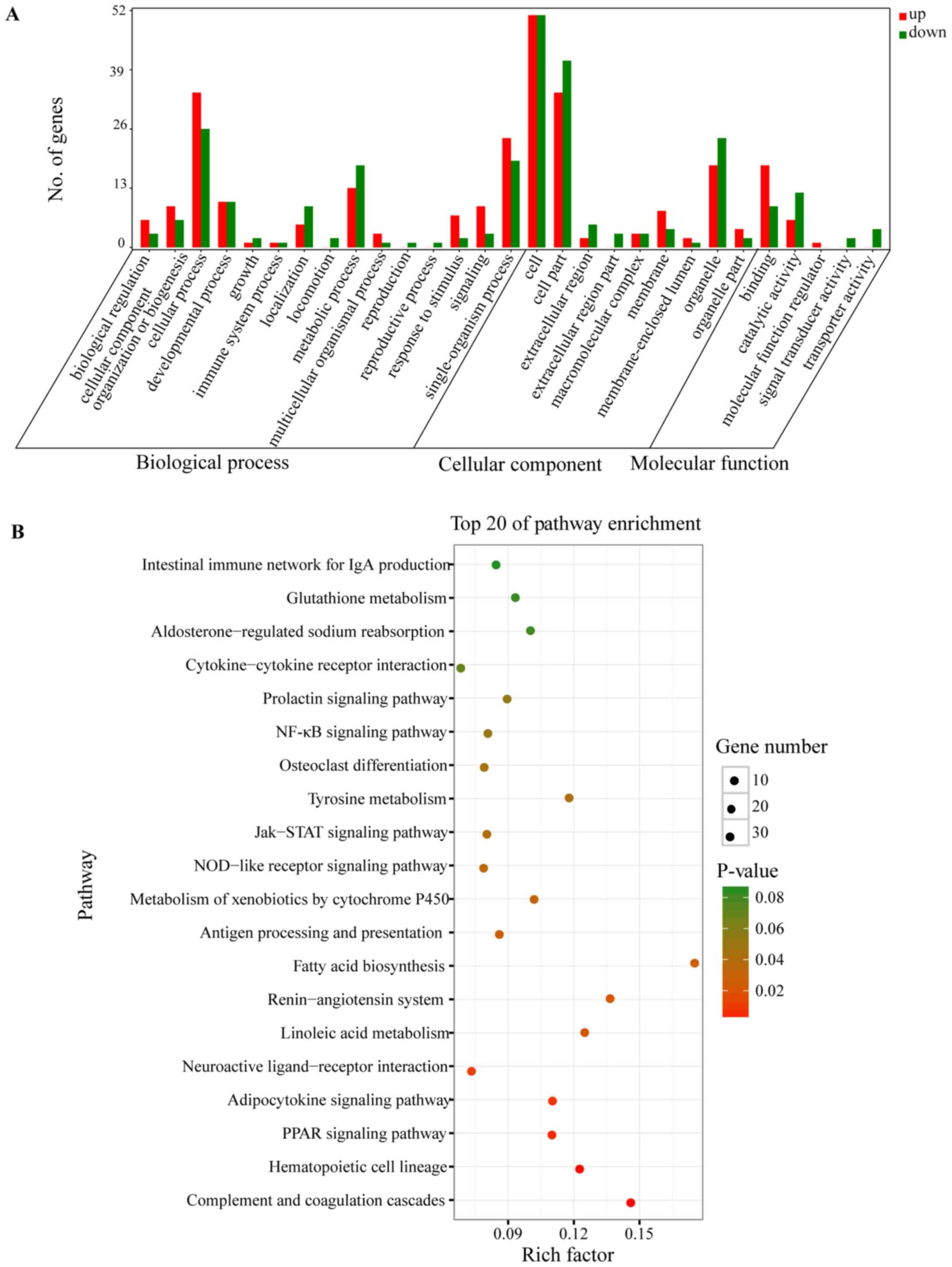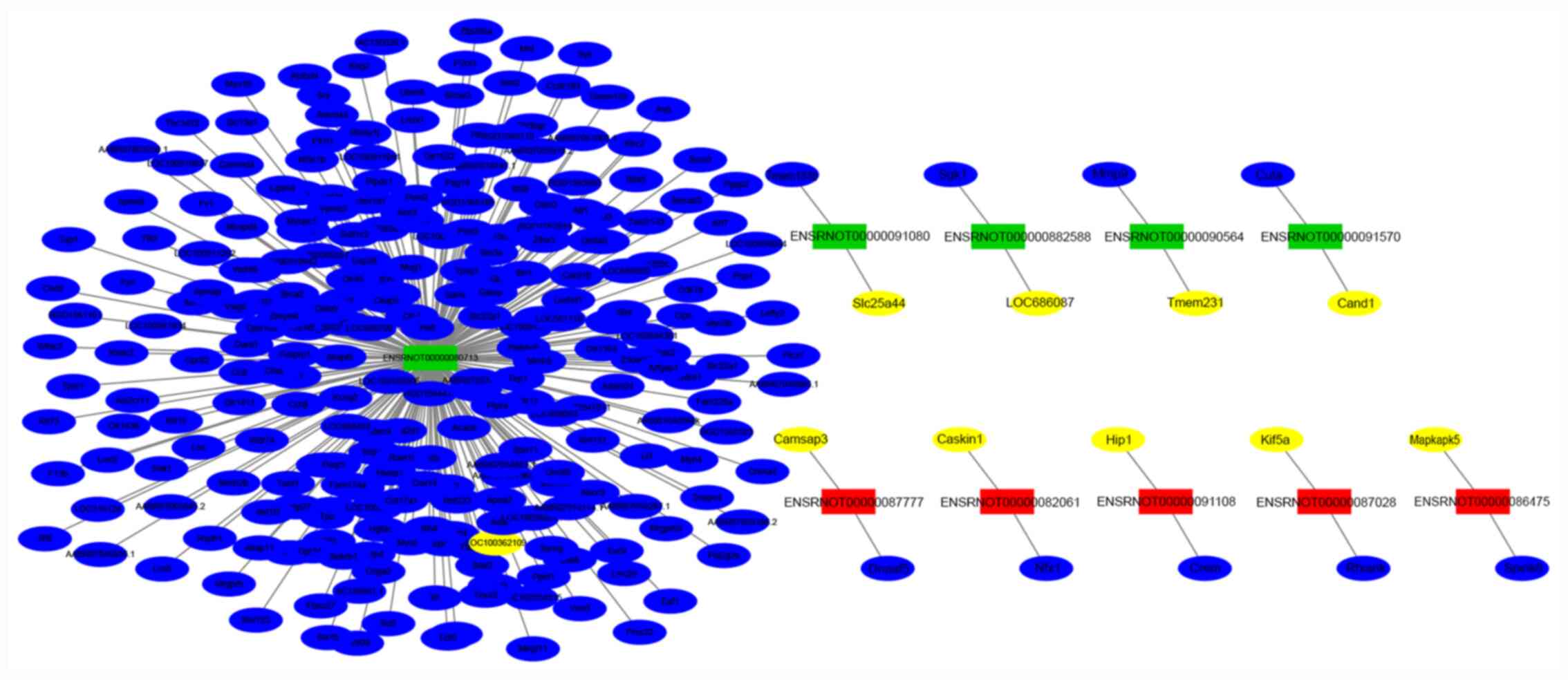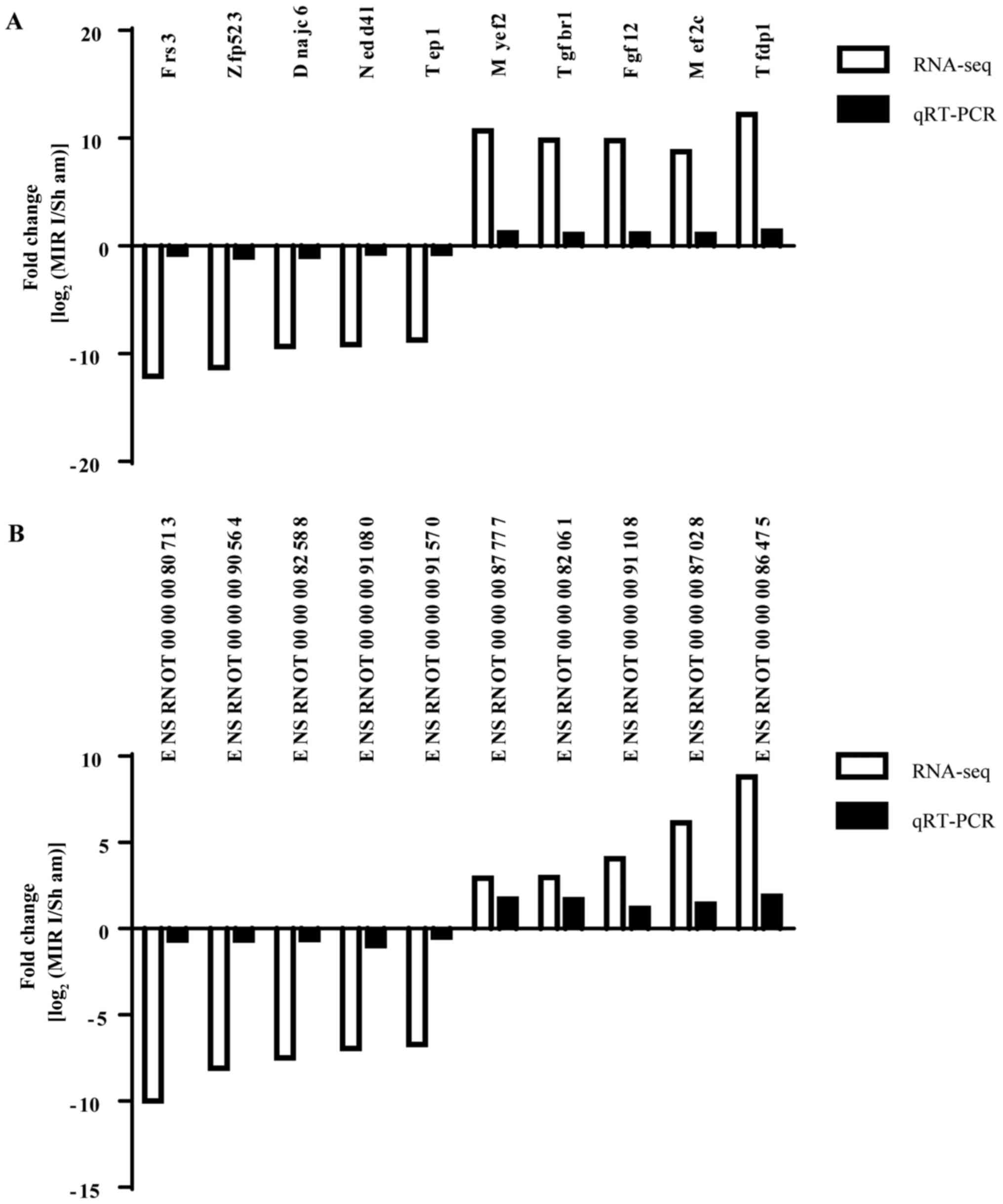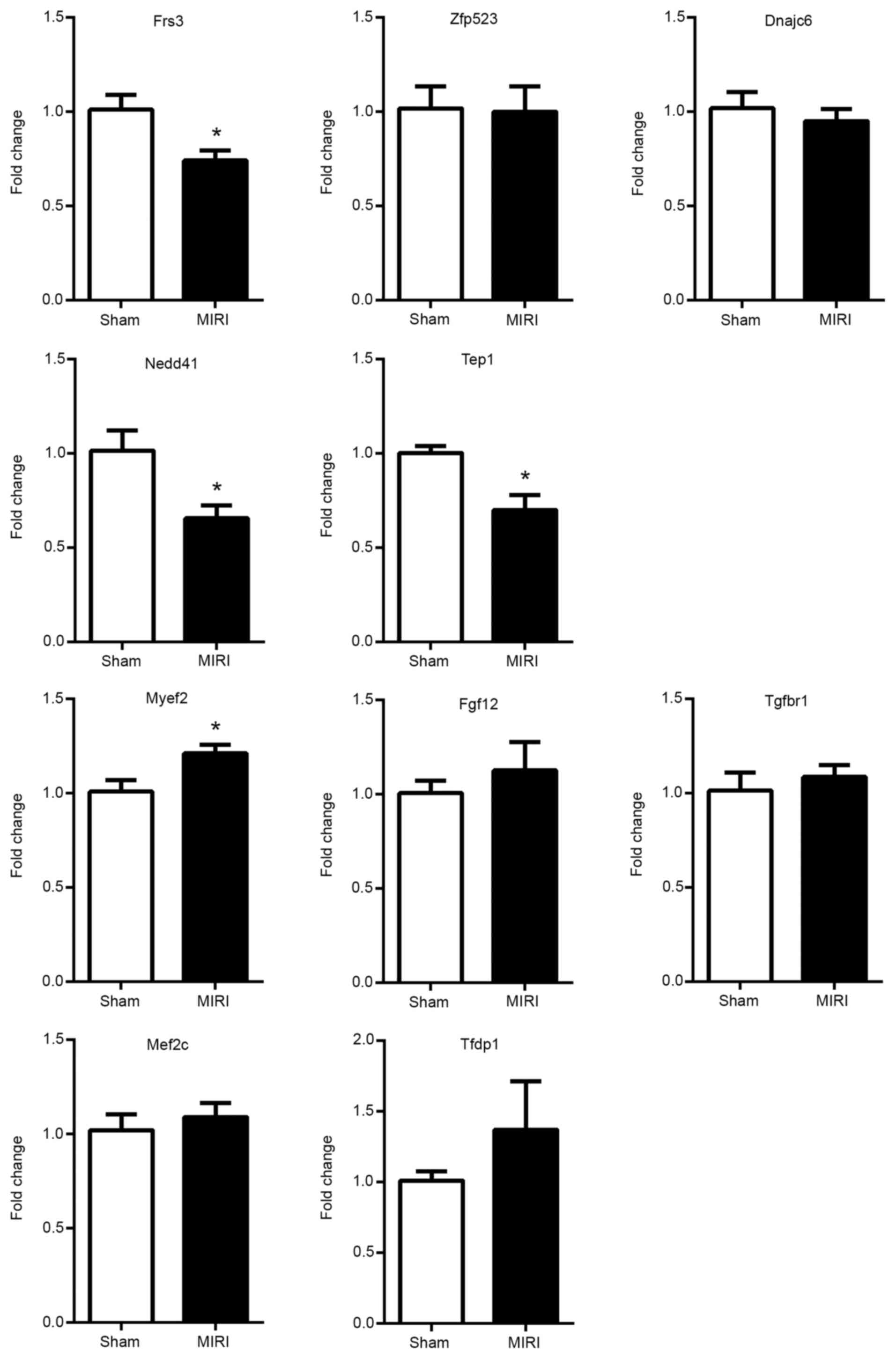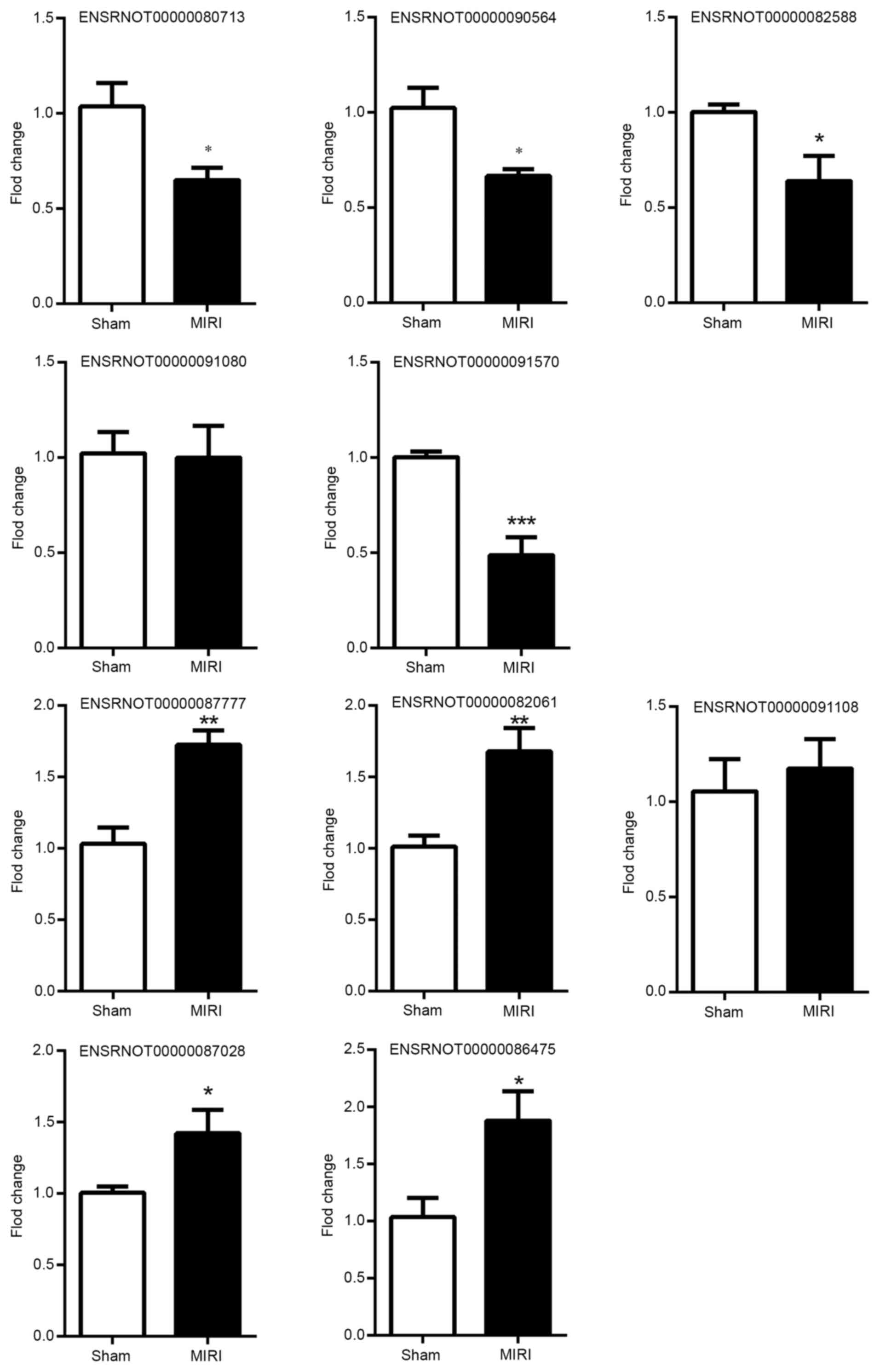|
1
|
Khan MA, Hashim MJ, Mustafa H, Baniyas MY,
Al Suwaidi SK, AlKatheeri R, Alblooshi FM, Almatrooshi ME, Alzaabi
ME, Al Darmaki RS and Lootah SN: Global epidemiology of ischemic
heart disease: Results from the global burden of disease study.
Cureus. 12(e9349)2020.PubMed/NCBI View Article : Google Scholar
|
|
2
|
Roth GA, Johnson C, Abajobir A, Abd-Allah
F, Abera SF, Abyu G, Ahmed M, Aksut B, Alam T, Alam K, et al:
Global, regional, and national burden of cardiovascular diseases
for 10 causes, 1990 to 2015. J Am Coll Cardiol. 70:1–25.
2017.PubMed/NCBI View Article : Google Scholar
|
|
3
|
Yellon DM and Hausenloy DJ: Myocardial
reperfusion injury. N Engl J Med. 357:1121–1135. 2007.PubMed/NCBI View Article : Google Scholar
|
|
4
|
Grace PA: Ischemia-reperfusion injury. Br
J Surg. 81:637–647. 1994.PubMed/NCBI View Article : Google Scholar
|
|
5
|
Cheng YF, Chang YT, Chen WH, Shih HC, Chen
YH, Shyu BC and Chen CC: Cardioprotection induced in a mouse model
of neuropathic pain via anterior nucleus of paraventricular
thalamus. Nat Commun. 8(826)2017.PubMed/NCBI View Article : Google Scholar
|
|
6
|
Xu A, Song Z, Peng Y and Xiang H: Change
of mitochondrial function in the early stage after cardiac
ischemia-reperfusion injury in mice. Int J Clin Exp Med.
9:2549–2554. 2016.
|
|
7
|
De Hert S and Moerman A: Myocardial injury
and protection related to cardiopulmonary bypass. Best Pract Res
Clin Anaesthesiol. 29:137–149. 2015.PubMed/NCBI View Article : Google Scholar
|
|
8
|
Murphy E and Steenbergen C: Mechanisms
underlying acute protection from cardiac ischemia-reperfusion
injury. Physiol Rev. 88:581–609. 2008.PubMed/NCBI View Article : Google Scholar
|
|
9
|
Saddic LA, Howard-Quijano K, Kipke J, Kubo
Y, Dale EA, Hoover D, Shivkumar K, Eghbali M and Mahajan A:
Progression of myocardial ischemia leads to unique changes in
immediate-early gene expression in the spinal cord dorsal horn. Am
J Physiol Heart Circ Physiol. 315:H1592–H1601. 2018.PubMed/NCBI View Article : Google Scholar
|
|
10
|
Waldron NH, Fudim M, Mathew JP and Piccini
JP: Neuromodulation for the treatment of heart rhythm disorders.
JACC Basic Transl Sci. 4:546–562. 2019.PubMed/NCBI View Article : Google Scholar
|
|
11
|
Shen MJ and Zipes DP: Role of the
autonomic nervous system in modulating cardiac arrhythmias. Circ
Res. 114:1004–1021. 2014.PubMed/NCBI View Article : Google Scholar
|
|
12
|
Hua F, Ardell JL and Williams CA: Left
vagal stimulation induces dynorphin release and suppresses
substance P release from the rat thoracic spinal cord during
cardiac ischemia. Am J Physiol Regul Integr Comp Physiol.
287:R1468–R1477. 2004.PubMed/NCBI View Article : Google Scholar
|
|
13
|
Steagall RJ, Sipe AL, Williams CA, Joyner
WL and Singh K: Substance p release in response to cardiac ischemia
from rat thoracic spinal dorsal horn is mediated by trpv1.
Neuroscience. 214:106–119. 2012.PubMed/NCBI View Article : Google Scholar
|
|
14
|
Ding X, Ardell JL, Hua F, McAuley RJ,
Sutherly K, Daniel JJ and Williams CA: Modulation of cardiac
ischemia-sensitive afferent neuron signaling by preemptive C2
spinal cord stimulation: Effect on substance P release from rat
spinal cord. Am J Physiol Regul Integr Comp Physiol. 294:R93–R101.
2008.PubMed/NCBI View Article : Google Scholar
|
|
15
|
Gao C, Howard-Quijano K, Rau C, Takamiya
T, Song Y, Shivkumar K, Wang Y and Mahajan A: Inflammatory and
apoptotic remodeling in autonomic nervous system following
myocardial infarction. PLoS One. 12(e0177750)2017.PubMed/NCBI View Article : Google Scholar
|
|
16
|
Niu YL, Guo Z and Zhou RH: Up-Regulation
of TNF-alpha in neurons of dorsal root ganglia and spinal cord
during coronary artery occlusion in rats. Cytokine. 47:23–29.
2009.PubMed/NCBI View Article : Google Scholar
|
|
17
|
Guo Z, Niu YL, Zhang JW and Yao TP:
Coronary artery occlusion alters expression of substance P and its
mRNA in spinal dorsal horn in rats. Neuroscience. 145:669–675.
2007.PubMed/NCBI View Article : Google Scholar
|
|
18
|
Wang Q, He ZG, Li ZX, Li SY, Chen YL, Feng
MH, Hong QX and Xiang HB: Bioinformatics analysis of gene
expression profile data to screen key genes involved in cardiac
ischemia-reperfusion injury. Int J Clin Exp Med. 11:4955–4966.
2018.
|
|
19
|
Trapnell C, Roberts A, Goff L, Pertea G,
Kim D, Kelley DR, Pimentel H, Salzberg SL, Rinn JL and Pachter L:
Differential gene and transcript expression analysis of RNA-seq
experiments with TopHat and Cufflinks. Nat Protoc. 7:562–578.
2012.PubMed/NCBI View Article : Google Scholar
|
|
20
|
Trapnell C, Williams BA, Pertea G,
Mortazavi A, Kwan G, van Baren MJ, Salzberg SL, Wold BJ and Pachter
L: Transcript assembly and quantification by RNA-Seq reveals
unannotated transcripts and isoform switching during cell
differentiation. Nat Biotechnol. 28:U511–U174. 2010.PubMed/NCBI View
Article : Google Scholar
|
|
21
|
Chen M, Li ZX, Wang Q and Xiang HB:
Altered expression of differential genes in thoracic spinal cord
involved in experimental cholestatic itch mouse model. Curr Med
Sci. 38:679–683. 2018.PubMed/NCBI View Article : Google Scholar
|
|
22
|
Wang Q, Li ZX, Liu BW, He ZG, Liu C, Chen
M, Liu SG, Wu WZ and Xiang HB: Altered expression of differential
gene and lncRNA in the lower thoracic spinal cord on different time
courses of experimental obstructive jaundice model accompanied with
altered peripheral nociception in rats. Oncotarget.
8:106098–106112. 2017.PubMed/NCBI View Article : Google Scholar
|
|
23
|
Liu QQ, Liu H, He ZG, Zhang SJ, Liu BW,
Wang L, Qiu WH, Xu Q, Xiang HB and Lv YM: Differential gene and
lncRNA expression in the lower thoracic spinal cord following
ischemia/reperfusion-induced acute kidney injury in rats.
Oncotarget. 8:53465–53481. 2017.PubMed/NCBI View Article : Google Scholar
|
|
24
|
Wang QL, Ai HZ, Liu JL, Xu M, Zhou Z, Qian
C, Xie Y and Yan J: Characterization of novel lnc RNAs in the
spinal cord of rats with lumbar disc herniation. J Pain Res.
12:501–512. 2019.PubMed/NCBI View Article : Google Scholar
|
|
25
|
National Research Council (US) Institute
for Laboratory Animal Research. In: Guide for the Care and Use of
Laboratory Animals. National Academies Press (US), Washington, DC,
1996.
|
|
26
|
Wang Q, Li ZX, Li YJ, Manyande A, Li SY,
Feng MH, Wu DZ and Xiang HB: Alterations in amino acid levels and
metabolite ratio of spinal cord in rat with myocardial
ischemia-reperfusion injury by proton magnetic resonance
spectroscopy. Am J Transl Res. 11:3101–3108. 2019.PubMed/NCBI
|
|
27
|
Wang Q, Li ZX, Li YJ, He ZG, Chen YL, Feng
MH, Li SY, Wu DZ and Xiang HB: Identification of lncRNA and mRNA
expression profiles in rat spinal cords at various timepoints
following cardiac ischemia/reperfusion. Int J Mol Med.
43:2361–2375. 2019.PubMed/NCBI View Article : Google Scholar
|
|
28
|
Pan XC, Li ZX, Wu DZ, Li SY, Xiang HB and
Song YT: Mapping changes of whole brain blood flow in rats with
myocardial ischemia/reperfusion injury assessed by positron
emission tomography. Curr Med Sci. 39:653–657. 2019.PubMed/NCBI View Article : Google Scholar
|
|
29
|
Li SY, Li ZX, He ZG, Wang Q, Li YJ, Yang
Q, Wu DZ, Zeng HL and Xiang HB: Quantitative proteomics reveal the
alterations in the spinal cord after myocardial
ischemia-reperfusion injury in rats. Int J Mol Med. 43:1877–1887.
2019.PubMed/NCBI View Article : Google Scholar
|
|
30
|
Xu Z, Alloush J, Beck E and Weisleder N: A
murine model of myocardial ischemia-reperfusion injury through
ligation of the left anterior descending artery. J Vis Exp.
10(51329)2014.PubMed/NCBI View
Article : Google Scholar
|
|
31
|
Liu S, Yang Y, Song YQ, Geng J and Chen
QL: Protective effects of N(2)LalanylLglutamine mediated by the
JAK2/STAT3 signaling pathway on myocardial ischemia reperfusion.
Mol Med Rep. 17:5102–5108. 2018.PubMed/NCBI View Article : Google Scholar
|
|
32
|
Liu BW, Li ZX, He ZG, Wang Q, Liu C, Zhang
XW, Yang H and Xiang HB: Altered expression of itch-related
mediators in the lower cervical spinal cord in mouse models of two
types of chronic itch. Int J Mol Med. 44:835–846. 2019.PubMed/NCBI View Article : Google Scholar
|
|
33
|
Liu QQ, Liu H, He ZG, Zhang SJ, Liu BW,
Wang L, Qiu WH, Xu Q, Xiang HB and Lv YM: Differential gene and
lncRNA expression in the lower thoracic spinal cord following
ischemia/reperfusion-induced acute kidney injury in rats.
Oncotarget. 8:53465–53481. 2017.PubMed/NCBI View Article : Google Scholar
|
|
34
|
Pan N, Bhatti MZ, Zhang H, Ni B, Fan X and
Chen J: The encystment-related micrornas and its regulation
molecular mechanism in pseudourostyla cristata revealed by high
throughput small RNA sequencing. Int J Mol Sci.
21(2309)2020.PubMed/NCBI View Article : Google Scholar
|
|
35
|
Sun H, Wang J, Que J, Peng Y, Yu Y, Wang
L, Ye H, Huang K, Xue Y, Zhou Y and Ji K: RNA sequencing revealing
the role of AMP-activated protein kinase signaling in mice
myocardial ischemia reperfusion injury. Gene. 703:91–101.
2019.PubMed/NCBI View Article : Google Scholar
|
|
36
|
Ke C, Gao F, Tian X, Li C, Shi D, He W and
Tian Y: Slit2/Robo1 mediation of synaptic plasticity contributes to
bone cancer pain. Mol Neurobiol. 54:295–307. 2017.PubMed/NCBI View Article : Google Scholar
|
|
37
|
Liu BW, Li ZX, He ZG, Liu C, Xiong J and
Xiang HB: Altered expression of target genes of spinal cord in
different itch models compared with capsaicin assessed by RT-qPCR
validation. Oncotarget. 8:74423–74433. 2017.PubMed/NCBI View Article : Google Scholar
|
|
38
|
Fu Q, Shi D, Zhou Y, Zheng H, Xiang H,
Tian X, Gao F, Manyande A, Cao F, Tian Y and Ye D: MHC-I promotes
apoptosis of GABAergic interneurons in the spinal dorsal horn and
contributes to cancer induced bone pain. Exp Neurol. 286:12–20.
2016.PubMed/NCBI View Article : Google Scholar
|
|
39
|
Guan XH, Fu QC, Shi D, Bu HL, Song ZP,
Xiong BR, Shu B, Xiang HB, Xu B, Manyande A, et al: Activation of
spinal chemokine receptor CXCR3 mediates bone cancer pain through
an Akt-ERK crosstalk pathway in rats. Exp Neurol. 263:39–49.
2015.PubMed/NCBI View Article : Google Scholar
|
|
40
|
Xu B, Guan XH, Yu JX, Lv J, Zhang HX, Fu
QC, Xiang HB, Bu HL, Shi D, Shu B, et al: Activation of spinal
phosphatidylinositol 3-kinase/protein kinase B mediates pain
behavior induced by plantar incision in mice. Exp Neurol.
255:71–82. 2014.PubMed/NCBI View Article : Google Scholar
|
|
41
|
Livak KJ and Schmittgen TD: Analysis of
relative gene expression data using real-time quantitative PCR and
the 2(-Delta Delta C(T)) method. Methods. 25:402–408.
2001.PubMed/NCBI View Article : Google Scholar
|
|
42
|
Huang C, Wang J, Wang N, Du F, Xiong W,
Qian J, Zhong K, Cai A, Xu S, Huang J, et al: Effect of myocardial
ischemic preconditioning on ischemia-reperfusion
stimulation-induced activation in rat thoracic spinal cord with
functional MRI. Int J Cardiol. 285:59–64. 2019.PubMed/NCBI View Article : Google Scholar
|
|
43
|
Rajendran PS, Nakamura K, Ajijola OA,
Vaseghi M, Armour JA, Ardell JL and Shivkumar K: Myocardial
infarction induces structural and functional remodelling of the
intrinsic cardiac nervous system. J Physiol. 594:321–341.
2016.PubMed/NCBI View Article : Google Scholar
|
|
44
|
Huang WA, Boyle NG and Vaseghi M: Cardiac
innervation and the autonomic nervous system in sudden cardiac
death. Card Electrophysiol Clin. 9:665–679. 2017.PubMed/NCBI View Article : Google Scholar
|
|
45
|
Dae MW, Lee RJ, Ursell PC, Chin MC,
Stillson CA and Moise NS: Heterogeneous sympathetic innervation in
German shepherd dogs with inherited ventricular arrhythmia and
sudden cardiac death. Circulation. 96:1337–1342. 1997.PubMed/NCBI View Article : Google Scholar
|
|
46
|
Stramba-Badiale M, Lazzarotti M and
Schwartz PJ: Development of cardiac innervation, ventricular
fibrillation, and sudden infant death syndrome. Am J Physiol.
263:H1514–H1522. 1992.PubMed/NCBI View Article : Google Scholar
|
|
47
|
Schwartz PJ: Cardiac sympathetic
innervation and the prevention of sudden death. Cardiologia.
35:51–54. 1990.PubMed/NCBI
|
|
48
|
Scalercio L, Vitter J and Elliott CE:
Placement of a continuous stellate ganglion block for treatment of
refractory ventricular fibrillation in the setting of known
prinzmetal angina during pregnancy: A case report. A A Pract.
12:106–108. 2019.PubMed/NCBI View Article : Google Scholar
|
|
49
|
Imran TF, Malapero R, Qavi AH, Hasan Z, de
la Torre B, Patel YR, Yong RJ, Djousse L, Gaziano JM and
Gerhard-Herman MD: Efficacy of spinal cord stimulation as an
adjunct therapy for chronic refractory angina pectoris. Int J
Cardiol. 227:535–542. 2017.PubMed/NCBI View Article : Google Scholar
|
|
50
|
Dobias M, Michalek P, Neuzil P, Stritesky
M and Johnston P: Interventional treatment of pain in refractory
angina. A review. Biomed Pap Med Fac Univ Palacky Olomouc Czech
Repub. 158:518–527. 2014.PubMed/NCBI View Article : Google Scholar
|
|
51
|
Deer TR, Mekhail N, Provenzano D, Pope J,
Krames E, Thomson S, Raso L, Burton A, DeAndres J, Buchser E, et
al: The appropriate use of neurostimulation of the spinal cord and
peripheral nervous system for the treatment of chronic pain and
ischemic diseases: The neuromodulation appropriateness consensus
committee. Neuromodulation. 17:515–550. 2014.PubMed/NCBI View Article : Google Scholar
|
|
52
|
Sylvén C: Neurophysiological aspects of
angina pectoris. Z Kardiol. 86:95–105. 1997.PubMed/NCBI
|
|
53
|
Pan X, Bao H, Si Y, Xu C, Chen H, Gao X,
Xie X, Xu Y, Sun F and Zeng L: Spinal cord stimulation for
refractory angina pectoris: A systematic review and meta-analysis.
Clin J Pain. 33:543–551. 2017.PubMed/NCBI View Article : Google Scholar
|
|
54
|
Hombach V, Grebe O, Merkle N, Waldenmaier
S, Höher M, Kochs M, Wöhrle J and Kestler HA: Sequelae of acute
myocardial infarction regarding cardiac structure and function and
their prognostic significance as assessed by magnetic resonance
imaging. Eur Heart J. 26:549–557. 2005.PubMed/NCBI View Article : Google Scholar
|
|
55
|
Bär FW, Tzivoni D, Dirksen MT,
Fernández-Ortiz A, Heyndrickx GR, Brachmann J, Reiber JH, Avasthy
N, Tatsuno J, Davies M, et al: Results of the first clinical study
of adjunctive CAldaret (MCC-135) in patients undergoing primary
percutaneous coronary intervention for ST-elevation myocardial
infarction: The randomized multicentre CASTEMI study. Eur Heart J.
27:2516–2523. 2006.PubMed/NCBI View Article : Google Scholar
|
|
56
|
Hearse DJ, Humphrey SM and Chain EB:
Abrupt reoxygenation of the anoxic potassium-arrested perfused rat
heart: A study of myocardial enzyme release. J Mol Cell Cardiol.
5:395–407. 1973.PubMed/NCBI View Article : Google Scholar
|
|
57
|
Herzog WR, Vogel RA, Schlossberg ML,
Edenbaum LR, Scott HJ and Serebruany VL: Short-Term low dose
intracoronary diltiazem administered at the onset of reperfusion
reduces myocardial infarct size. Int J Cardiol. 59:21–27.
1997.PubMed/NCBI View Article : Google Scholar
|
|
58
|
De Stefani D, Raffaello A, Teardo E, Szabò
I and Rizzuto R: A forty-kilodalton protein of the inner membrane
is the mitochondrial calcium uniporter. Nature. 476:336–340.
2011.PubMed/NCBI View Article : Google Scholar
|
|
59
|
Hausenloy DJ and Yellon DM: The
mitochondrial permeability transition pore: Its fundamental role in
mediating cell death during ischaemia and reperfusion. J Mol Cell
Cardiol. 35:339–341. 2003.PubMed/NCBI View Article : Google Scholar
|
|
60
|
Argaud L, Gateau-Roesch O, Muntean D,
Chalabreysse L, Loufouat J, Robert D and Ovize M: Specific
inhibition of the mitochondrial permeability transition prevents
lethal reperfusion injury. J Mol Cell Cardiol. 38:367–374.
2005.PubMed/NCBI View Article : Google Scholar
|
|
61
|
Pang KC, Frith MC and Mattick JS: Rapid
evolution of noncoding RNAs: Lack of conservation does not mean
lack of function. Trends Genet. 22:1–5. 2006.PubMed/NCBI View Article : Google Scholar
|
|
62
|
Wang P, Luo ML, Song E, Zhou Z, Ma T, Wang
J, Jia N, Wang G, Nie S, Liu Y and Hou F: Long noncoding RNA
lnc-TSI inhibits renal fibrogenesis by negatively regulating the
TGF-beta/smad3 pathway. Sci Transl Med. 10:2018.PubMed/NCBI View Article : Google Scholar
|
|
63
|
Bejerano G, Pheasant M, Makunin I, Stephen
S, Kent WJ, Mattick JS and Haussler D: Ultraconserved elements in
the human genome. Science. 304:1321–1325. 2004.PubMed/NCBI View Article : Google Scholar
|
|
64
|
Li D and Yang MQ: Identification and
characterization of conserved lncRNAs in human and rat brain. BMC
Bioinformatics. 18(489)2017.PubMed/NCBI View Article : Google Scholar
|
|
65
|
Sun Y, Fan W, Xue R, Dong B, Liang Z, Chen
C, Li J, Wang Y, Zhao J, Huang H, et al: Transcribed ultraconserved
regions, Uc.323, ameliorates cardiac hypertrophy by regulating the
transcription of CPT1b (Carnitine Palmitoyl transferase 1b).
Hypertension. 75:79–90. 2020.PubMed/NCBI View Article : Google Scholar
|















